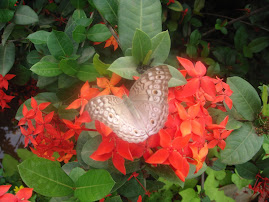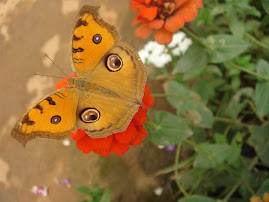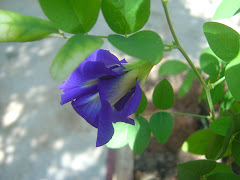

The very prolific Racquel--Perennial Garden Lover--had a
post titled Seedhead and Berries on Oct.9. Reading that
interesting post, I thought about this particular plant.
The seedhead does look a little strange and some are almost
grotesque in shape.
There are several names for this plant; Malabar spinach, Ceylon
spinach, Vietnamese spinach, Slippery vegetable and Vine spinach.
It does taste like spinach but it has a mild flavour. Whereas
spinach is smooth in texture when cooked, this one becomes slimy
if over-cooked. This is because of a thick gluey substance rather
like okra, so care must be taken not to cook it for long.
Said to be originally from India, it is found all across south-
Asia and Africa. The botanical name is Basella alba or Basella
rubra. The B. alba is the light green variety whereas the
purplish-stemmed ones are B. rubra. I have the latter, but it
is slightly different from the ones you might see on certain
web pages. The leaves and stems are smaller and the leaves are
not thick.
In our area, the smaller type grows like weeds, which is why I
could separate the various stages of seeds for the photos. I
treat them like weeds too, uprooting them as they spring up
even in pots, ready to twine and choke the plant the pot was
intended for!

I remember reading in someone's blog ( I can't remember the name)
that one should never be happy about really fast-growing plants
as they tend to be invasive. How true about the basella!
Propagation is by seeds and stems. Cuttings do not take long
take root. A very easy to grow plant indeed!
This soft-stemmed vine tolerates high rainfall and humidity. Even
if the soil is fairly poor, it'll still do well.
Like any other leafy green vegetable, it is high in vitamin A, C,
iron and calcium. LIke berries, the ripe seeds yield a rich purplish-
red colour when crushed. The dye is used for official seals, rouge,
and even food colour. The colour is enhanced by adding lemon juice.

The last photo is a mixed vegetable I cooked. It has bits of
pumpkin, potatoes and basella. Here I've added only the leaves
but tender stems are consumed too. I like to have the stems in
mustard sauce. We also add the finely chopped leaves to fish curry.













































.jpg)

































5 comments:
Oh yum! Can you tell it is breakfast time? That is a cool plant with the seedheads. Very pretty colors and quite attractive in the bowl with the three types of berries seeds.
Kanak, I always look forward to seeing your posts. I know I am always going to find something so unique and different. This is an interesting plant. I like the picture of it in the bowl all broken down into the different parts of it. A little milder than spinach? Must taste really good!!!
I know this plant well from my childhood in Trinidad, where it is called "poui bhagi". A few leaves can be cooked in dals where it melts down, adding taste and nutrition and you don't get the slimy feel.
Yes, it grows like a weed in wet areas, but in the dry island I now live in I'll have little luck unless I water every day.
I like the seedheads on those Spinach plants. Very unusual & pretty in color. Thanks for mentioning my post, how sweet of you. That vegetable dish looks yummy.
Thanks Tina. Yes, the colour is pretty. As kids we loved to crush the seeds and marvel at the colour!
Susie, thank you so much...I love to visit you too!! Spinach is milder, not these leaves. I'm sure you'll love it!
Hi Nicole, thanks for visiting. This is called pui in eastern India. In Assam we call it pui haax. In many Assamese words the 'x' denotes the same sound as the ending in the Scottish word 'loch'.
Yes, it tastes good in dal, glad you mentioned this.
Racquel, thanks. Glad to read your comment and good luck with your pecan harvest.
Post a Comment